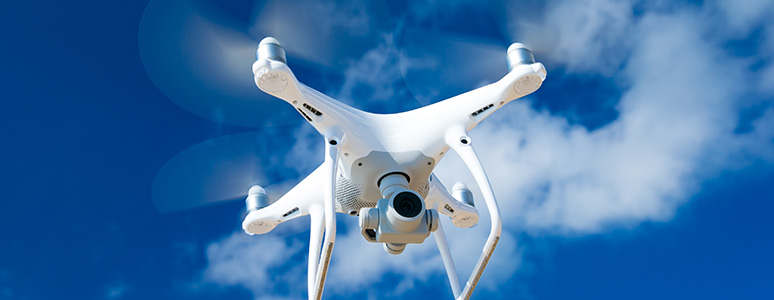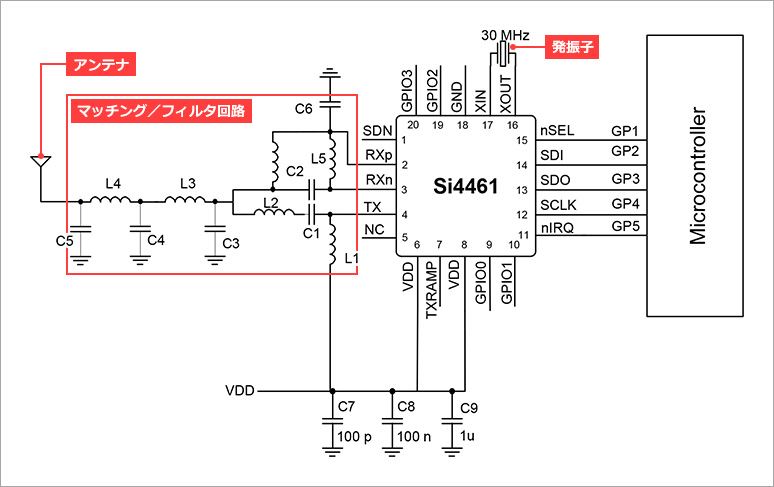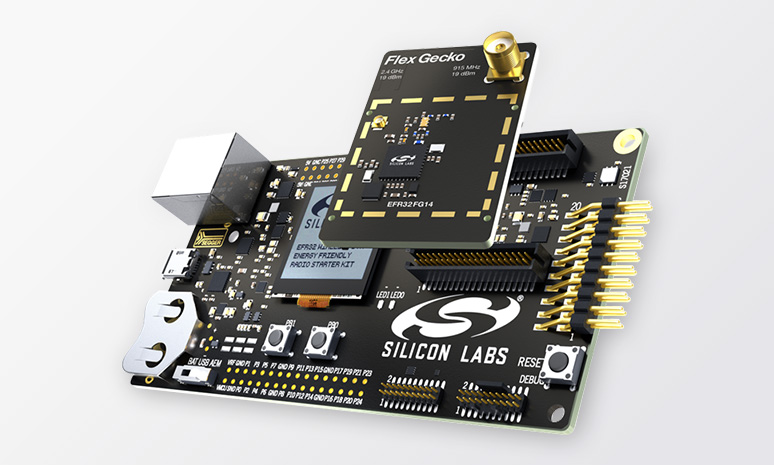Bluetooth®, Wi-Fi, Zigbee, Thread, Z-Wave, Sub-GHz... Silicon Labs has a wide range of very attractive wireless solutions. We would like to introduce you to our attractive product line.
Silicon Labs/Wireless Course series overview
The 4th is "Sub-GHz basics".
This article introduces the basics of wireless systems using Sub-GHz and Sub-GHz compatible products from SiliconLabs.
What is Sub-GHz?
Along with Bluetooth and Wi-Fi, "Sub-GHz" is often considered as a candidate when considering wireless systems.
If you are unfamiliar with the term sub-giga, how about using the terms 920MHz, extra-small (specified low-power radio), and proprietary radio (proprietary)?
In a broad sense, sub-giga refers to frequencies below 1 GHz, but in a narrow sense, it can refer to a specific frequency, and in Japan, it often refers to communications using 920 MHz.
Even such a wireless standard uses subgiga
Some wireless standards use subgiga instead of 2.4GHz because subgiga has advantages over 2.4GHz.
| Communication standard | remarks |
| Wi-Sun | A communication standard originating in Japan that is used in Japan's electric power smart meters. Japan uses 920MHz. |
| LoRaWAN, SIGFOX | A representative of LPWA (Low Power Wide Area) that enables long-distance communication while consuming low power. Japan uses 920MHz. |
| Z-Wave | A communication standard used in smart homes. Japan uses 920MHz. |
These wireless standards are not often called sub-giga but are called by their respective designations (Wi-Sun for Wi-Sun).
Therefore, the term "sub-giga" is often used only for communications using proprietary protocols.
Applications that make use of Subgiga
Sub-GHz is often compared to 2.4GHz, but it has both advantages and disadvantages. A thorough understanding of these issues will make it possible to select the optimal wireless method.
Details will be introduced next time, but the advantages and disadvantages of using Subgiga are as follows.
merit
- Resistant to obstacles
- strong outdoors
- good signal environment
Demerit
- Available frequencies vary by country
- Poor connection with display devices
Based on these, we would like to introduce some applications where Subgiga is already used or expected to be used in the future.
[Application 1] Factory sensor network
IoT and smart factories are progressing, but wireless is used for monitoring and remote control of facilities and equipment using sensors.
There are many obstacles in the factory, and it is an application that can take advantage of the features of Sub-Giga, which is strong against going around.
Conventionally, sub-giga (426 MHz band) was used, but the use of 920 MHz band, which has more channels and a better radio wave environment, is progressing.

[Application 2] Preventive maintenance of bridges, tunnels, etc.
Transportation infrastructure such as bridges and tunnels is regularly inspected to ensure safety. However, the inspection frequency is not so high.
By placing sensor nodes to detect anomalies at various locations in bridges and tunnels, and using Subgiga to collect and analyze the acquired information, constant monitoring becomes possible.
As a result, safety can be further enhanced, and it is useful for planning efficient inspection plans.
It is also expected to be used for monitoring landslides in mountains.
In such applications, it is often the case that a power supply cannot be secured, so it is necessary to operate with cells/batteries. In addition, it is assumed that sensor nodes will be installed in places where installation or replacement is not easy. (On/under bridges, in tunnels, in mountains, etc.)
Therefore, low power consumption design of the sensor node is required, and sub-giga is the most suitable for low power design compared to 2.4 GHz.
Also, even in environments with obstacles such as trees, it is easier to obtain a communication distance with sub-giga than 2.4GHz, which is one of the reasons why sub-giga is preferred.

[App ③] Drone
Drones are gradually becoming popular for hobbies and aerial photography, but in the future it is expected to expand to commercial applications such as logistics, agriculture, forestry and fisheries, surveying, and infrastructure management.
Drones are expected to use multiple frequencies, such as sub-giga, which is good at long-distance communication, for operation, and 2.4 GHz, which is good at high-speed data communication, for image transfer.
As sub-giga, in addition to 920MHz, which does not require a radio station license, 169MHz, which requires a license, is expected to be used. 169MHz is a newly opened frequency band, and it has the property that it is easier to obtain communication distance than 920MHz.

Silicon Labs Sub-GHz Solution
Silicon Labs' Sub-GHz business started with the acquisition of Integration Associates, which had extremely advanced technology in the design of sub-GHz compatible wireless chips.
Looking back on the history of 920MHz in Japan, it originally started with the opening of 950MHz in 2008. After that, 950MHz was allocated to mobile phones (SoftBank Corp.) in the frequency reorganization, and devices that used 950MHz were moved to 920MHz.
At that time, the only high-performance wireless chip on the market that could achieve 950MHz was Integration Associates' IA4430 (Silicon Lab's part number: Si4430). It was an era when everyone used Silicon Labs products.
Silicon Labo's Subgiga has been in the Japanese market for a long time and has a proven track record of continued use.
The lineup of Subgiga products includes wireless chips (only the wireless part) and SOCs (integrated wireless chip and microcomputer).
| category | series name | remarks |
| radio chip | Si4x6x (EZRadioPRO) | ― |
| Si4x5x (EZRadio) | Si4x6x low-performance, low-cost product | |
| SOC | Si10xx | Integrated wireless chip and 8-bit microcomputer |
| EZR32xx | Integrated wireless chip and 32-bit microcomputer | |
| EFR32FGxx | ― |
Here, we will focus on Si4x6x and EFR32FGxx, which have a proven track record in the Japanese market.
Si4x6x family (radio chips)
Si4x6x is the second generation product of the "EZRadioPRO" family, which is a high-performance, high-performance radio chip, and has greatly improved functions and performance from the first-generation Si4x3x family (mentioned above).
There are three product types: transceivers (transmit and receive), transmitters (transmit only), and receivers (receive only), and variations in transmit power are also available.
| Product number | product type | Transmission power (dBm) | Receiver sensitivity (dBm at 920MHz) |
| Si446x | Transceiver (TRX) | +20, +16, +13 | -104 (at 100kbps), -126 (at 500bps), -132 (at 100bps) |
| Si406x | Transmitter (TX) | +20, +13 | ― |
| Si4362 | Receiver (RX) | ― | -104 (at 100kbps), -127 (at 500bps) |
Since the wireless chip does not operate by itself, it becomes possible to operate by preparing an external controller (such as a microcomputer) and controlling it via a serial interface.
The control of Si4x6x adopts command-based control method instead of register-based. This has the advantage of reducing the design burden of the control software and increasing the reusability of the software.
In terms of function and performance,
- The same chip can support a wide range of frequencies from 119 to 1050MHz
- High output is possible without using an external PA (amplifier)
- high reception sensitivity
- Low power consumption
and many other features.
It is a product that combines the characteristics of experts, such as the beauty of the spectrum at the time of output and the high anti-interference performance (blocking).
Of course, I think that the large number of adoption results in Japan will be a reliable factor for recruitment.
The figure below is a typical circuit of Si446x (transceiver). As with the EFR32FG introduced next, it is necessary to optimize the component constants of the matching circuit according to the frequency you want to use.

EFR32FG Family (SoC)
The EFR32FG (Flex Gecko) family is a wireless microcontroller with an Arm® Cortex®-M4F core. FG1, FG12, FG13, FG14 and 4 families have been commercialized as of September 2018.
The basic structure is the same as the EFR32MG (Mighty Gecko) family introduced in the Zigbee edition, but the wireless protocols that can be installed are different. (Zigbee and Bluetooth cannot be implemented in EFR32FG)
The peripherals of the microcomputer part are also very rich, including serial interfaces such as SPI, I2C, and UART, analog peripherals such as ADC, DAC, and comparators, and hardware accelerators for encryption/decryption.
| Product number | flash memory | RAM |
| EFR32FG1 | 256 kB | 32 kB |
| EFR32FG12 | 1024 kB | 256 kB |
| EFR32FG13 | 512 kB | 64 kB |
| EFR32FG14 | 256 kB | 32 kB |
There are various variations of this EFR32FG, including those that support only sub-giga, those that support only 2.4GHz, and those that support both sub-giga and 2.4GHz.

The transmission output is basically +20dBm (+16.5dBm for FG1 only), but the output can be lowered by setting to comply with the radio laws of each country. Also, the product type is only a transceiver.
| Product number | product type | Transmission power (dBm) | Receiver sensitivity (dBm at 920MHz) |
| EFR32FGxx | transceiver (TRX) | +20, +16.5 (FG1 only) | -126.2 (at 600bps) -105.1 (at 100kbps) |
Compared to the 2-chip configuration of a wireless chip (Si4x6x) + control microcomputer, the EFR32FG is a single chip, enabling space-saving design.
Also, with two chips, it's a lot of work to check the operation first, but with one chip, it's a big advantage that the sample code that has been confirmed to work is provided.
Development of sub-giga equipment
We introduced the basic information of Sub-GHz and compatible products of Silicon Labs. How was it? If you need long-distance communication or cannot use 2.4GHz, please consider Sub-Giga compatible products from Silicon Labs.
Also, is it difficult to develop a sub-giga device on your own? For those who want to design quickly and put products on the market quickly, we recommend outsourcing development. If you are considering outsourcing development, please contact us from the following.
Next time, I would like to introduce the advantages and disadvantages of using Subgiga.
[Silicon Labs/Wireless Course] Sub-GHz Advantages/Disadvantages
Click here for recommended articles/materials
[Silicon Labs/Wireless Course] Sub-GHz Advantages/Disadvantages
[Silicon Labs/Wireless Course] Zigbee Basics
[Silicon Labs/Wireless Course] Zigbee Development Flow
[Silicon Labs/Wireless Course] Zigbee Environment Construction
Silicon Labs/Wireless Course series overview

